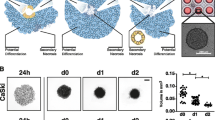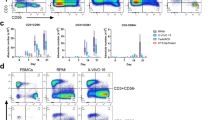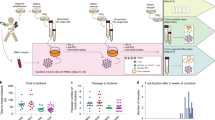Abstract
Adoptive immunotherapy with human cytotoxic T lymphocytes (CTL) is a promising cancer treatment. Previously we showed that human CTLs against various types of tumors can be efficiently produced by coculturing peripheral blood cells with target cells. The aims of this study were to simulate the interaction of CTLs and micrometer-size tumor tissues in vitro and to assess the required number of CTLs at local tumor sites for degradation of a tumor. Allogeneic CTLs against a human transitional cell carcinoma cell line and autologous CTLs against a renal cell carcinoma cell derived from a surgical specimen were generated. The cytotoxic activities of CTLs against tumor cells in monolayer culture and tumor spheroids formed in U-bottom 96-well culture plates were assessed. Both allogeneic and autologous CTLs showed greater destructive activity than lymphokine activated killer (LAK) cells against target tumor spheroids. CTLs inoculated at E/T ratios of 0.1 to 1 coexisted with the tumor spheroid for 5 to 6 days and then increased in number with apparently lethal activity against the tumor spheroid. In contrast to CTLs, the increase in LAK cell numbers was scarcely observed, and the proliferated LAK cells did not show cytotoxicity against the tumor spheroid. These observations suggest that, when a small number of CTLs reach a local tumor site, they can destroy micrometer-size tumors after considerable local proliferation.
Similar content being viewed by others
References
Adams DH, Yannelli JR, Newman W, Lawley T, Ades E, Rosenberg SA and Shaw S (1997) Adhesion of tumour-infiltrating lymphocytes to endothelium: a phenotypic and functional analysis. Br J Cancer 75: 1421–1431.
Bukowski RM, Scharfman W, Murphy S, Rayman P, Tubbs R, Alexander J, Budd GT, Sergi J, Bauer L, Gibson V, Stanley J, Boyett J, Pontes E and Finke J (1991) Clinical results and characterizations of tumor infiltrating-lymphocytes with or without recombinant interleukin-2 in human metastatic renal cell carcinoma. Cancer Res 51: 4199–4205.
Chang AE, Aruga A, Cameron MJ, Sondak VK, Normolle DP, Fox BA and Shu S (1997) Adoptive immunotherapy with vaccineprimed lymph node cells secondarily activated with anti-CD3 and interleukin-2. J Clin Oncol 15: 796–807.
Economou JS, Belldegrun AS, Glaspy J, Toloza EM, Figlin R, Hobbs J, Meldon N, Kaboo R, Tso C, Miller A, Lau R, McBride W and Moen RC (1996) In vivotrafficking of adoptively transferred interleukin-2 expanded tumor-infiltrating lymphocytes and peripheral blood lymphocytes. J Clin Invest 97: 515–521.
Iwasaki K, Kikuchi H, Miyatake S, Aoki T, Yamasaki T and Oda Y (1990) Infiltrative and cytolytic activities of lymphokineactivated killer cells against a human glioma spheroid model. Cancer Res 50: 2429–2436.
Jaaskelainen J, Kalliomaki P, Paetau A and Timonen T (1989) Effect of LAK cells against three-dimensional tumor tissue: In vitrostudy using multi-cellular human glioma spheroids as targets. J Immunol 142: 1036–1045.
Kawai K, Sasaki T, Saijou K, Akaza H, Koiso K and Ohno T (1992) Additive effects of antitumor drugs and lymphokine-activated killer cell cytotoxic activity in tumor cell killing determined by lactate-dehydrogenase-release assay. Cancer Immunol Immunother 35: 225–229.
Koide N, Sakaguchi K, Koide Y, Asano K, Kawaguchi M, Matsushima H, Takenami T, Shinji T, Mori M and Tsuji T (1990) Formation of multicellular spheroid composed of adult rat hepatocytes in dishes with positively charged surfaces and under other nonadherent environments. Exp Cell Res 189: 87–92.
Liu SQ, Saijo K, Todoroki K and Ohno T (1995) Induction of human autologous cytotoxic T lymphocytes on formalin-fixed and paraffin-embedded tumor sections. Nature Med 1: 267–271.
Liu SQ, Shiraiwa H, Kawai K, Hayashi H, Akaza H, Kim BS, Oki A, Nishida M, Kubo T, Hashizaki K, Saijo K and Ohno T (1996) Tumor-specific autologous cytotoxic T lymphocytes from tissue sections. Nature Med 2: 1283.
Liu SQ, Kawai K, Shiraiwa H, Hayashi H, Akaza H, Hashizaki K, Shiba R, Saijou K and Ohno T (1998) High rate of induction of human autologous cytotoxic T lymphocytes against renal cell carcinoma cells cultured with an interleukin cocktail.Jpn J Cancer Res 89: 1195–1201.
Lotze MT, Line BR, Mathisen DJ and Rosenber SA (1980) The in vivodistribution of autologous human and murine lymphoid cells grown in T cell growth factor (TCGF): Implications for adoptive immunotherapy for tumors.J Immunol 125: 1487–1493.
Matsumura T, Sussmann JJ, Krinock RA, Chang AE and Shu S (1994) Characteristics and in vivohoming of long-term Tcell lines and clones derived from tumor-draining lymph nodes. Cancer Res 54:2744–2750.
Merrouche Y, Negrier S, Bain C, Combaret V, Mercatello A, Coronel B, Moskovtchenko J, Tolstoshev P, Moen R, Philip T and Favrot MC (1995) Clinical application of retroviral gene transfer in oncology: Results of a French study with tumor infiltrating lymphocytes transduced with the gene of resistance to neomycin. J Clin Oncol 13:410–418.
Plautz GE, Barnett GH, Miller DW, Cohen BH, Prayson RA, Krauss JC, Luciano M, Kangisser DB and Shu S (1998) Systemic T cell adoptive immunotherapy of malignant gliomas.J Neurosurg 89:42–51.
Park JA, Brown RA, Kurt RA and Akporiaye T (1995) Studies of in vivorecruitment and activation of cytotoxic lymphocytes using a gelatin-sponge model of concomitant tumor immunity.Int J Cancer 62:421–427.
Pockaj BA, Sherry RM, Wei JP, Yannelli JR, Carter CS, Leitman SF, Carasquillo JA, Steinberg SM, Rosenberg SA and Yang JC (1994) Localization of 111-Indium-labeled tumor in-filtrating lymphocytes to tumor in patients receiving adoptive immunotherapy.Cancer 73:1731–1737.
Rosenberg SA, Packard BS, Aebersold PM, Solomon D, Topalian SL, Toy ST, Simon D, Lotze MT, Yang JC, Seipp GA, Simpson C, Carter C, Bock S, Schwartzentruber D, Wei JP and White DE (1988) Use of tumor-infiltrating lymphocytes and interleukin-2 in the immunotherapy of patients with metastatic melanoma.N Engl J Med 319: 1676–1680.
Topalian AL, Solomon D, Rosenberg SA (1989) Tumor-specific cytolysis by lymphocytes infiltrating human melanomas. J Immunol 142:3714–3725.
Yee C, Riddell SR and Greenberg PD (1997) Prospective for adoptive T cell therapy. Curr Opin Immunol 9:702–708.
Author information
Authors and Affiliations
Corresponding author
Rights and permissions
About this article
Cite this article
Kawai, K., Hayashi, H., Ozaki, Y. et al. Assessment of the number of local cytotoxic T lymphocytes required for degradation of micrometer-size tumor spheroids. Cytotechnology 37, 31–40 (2001). https://doi.org/10.1023/A:1016139010531
Issue Date:
DOI: https://doi.org/10.1023/A:1016139010531




